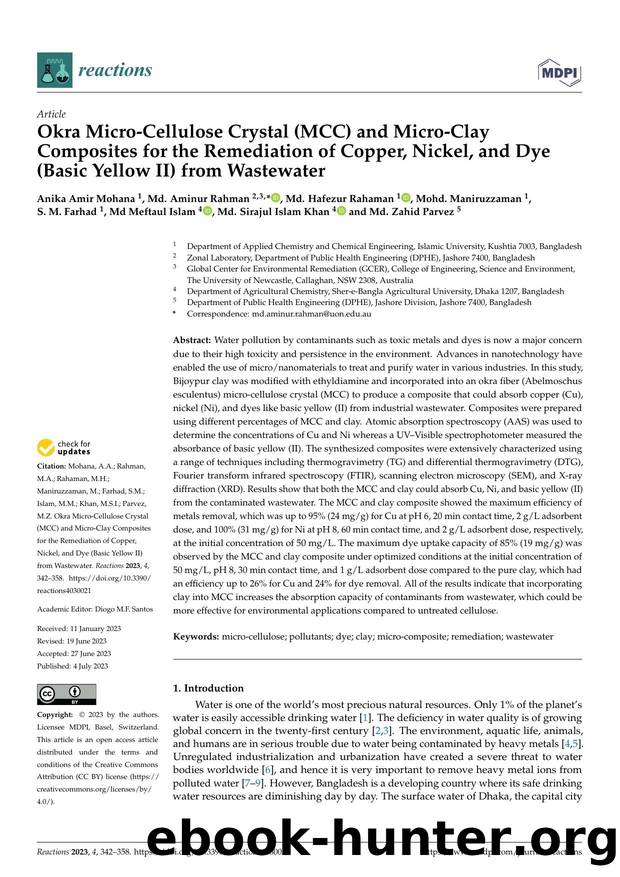Okra Micro-Cellulose Crystal (MCC) and Micro-Clay Composites for the Remediation of Copper, Nickel, and Dye (Basic Yellow II) from Wastewater by unknow

Author:unknow
Format: pdf
Tags: Water pollution by contaminants such as toxic metals and dyes is now a major concern due to their high toxicity and persistence in the environment. Advances in nanotechnology have enabled the use of micro/nanomaterials to treat and purify water in various industries. In this study, Bijoypur clay was modified with ethyldiamine and incorporated into an okra fiber (Abelmoschus esculentus) micro-cellulose crystal (MCC) to produce a composite that could absorb copper (Cu), nickel (Ni), and dyes like basic yellow (II) from industrial wastewater. Composites were prepared using different percentages of MCC and clay. Atomic absorption spectroscopy (AAS) was used to determine the concentrations of Cu and Ni whereas a UV–Visible spectrophotometer measured the absorbance of basic yellow (II). The synthesized composites were extensively characterized using a range of techniques including thermogravimetry (TG) and differential thermogravimetry (DTG), Fourier transform infrared spectroscopy (FTIR), scanning electron microscopy (SEM), and X-ray diffraction (XRD). Results show that both the MCC and clay could absorb Cu, Ni, and basic yellow (II) from the contaminated wastewater. The MCC and clay composite showed the maximum efficiency of metals removal, which was up to 95% (24 mg/g) for Cu at pH 6, 20 min contact time, 2 g/L adsorbent dose, and 100% (31 mg/g) for Ni at pH 8, 60 min contact time, and 2 g/L adsorbent dose, respectively, at the initial concentration of 50 mg/L. The maximum dye uptake capacity of 85% (19 mg/g) was observed by the MCC and clay composite under optimized conditions at the initial concentration of 50 mg/L, pH 8, 30 min contact time, and 1 g/L adsorbent dose compared to the pure clay, which had an efficiency up to 26% for Cu and 24% for dye removal. All of the results indicate that incorporating clay into MCC increases the absorption capacity of contaminants from wastewater, which could be more effective for environmental applications compared to untreated cellulose., micro-cellulose; pollutants; dye; clay; micro-composite; remediation; wastewater
Download
This site does not store any files on its server. We only index and link to content provided by other sites. Please contact the content providers to delete copyright contents if any and email us, we'll remove relevant links or contents immediately.
What's Done in Darkness by Kayla Perrin(25507)
Shot Through the Heart: DI Grace Fisher 2 by Isabelle Grey(18227)
Shot Through the Heart by Mercy Celeste(18169)
The Fifty Shades Trilogy & Grey by E L James(17783)
The 3rd Cycle of the Betrayed Series Collection: Extremely Controversial Historical Thrillers (Betrayed Series Boxed set) by McCray Carolyn(13197)
The Subtle Art of Not Giving a F*ck by Mark Manson(12925)
Scorched Earth by Nick Kyme(11843)
Stepbrother Stories 2 - 21 Taboo Story Collection (Brother Sister Stepbrother Stepsister Taboo Pseudo Incest Family Virgin Creampie Pregnant Forced Pregnancy Breeding) by Roxi Harding(11062)
Drei Generationen auf dem Jakobsweg by Stein Pia(10223)
Suna by Ziefle Pia(10188)
Scythe by Neal Shusterman(9271)
International Relations from the Global South; Worlds of Difference; First Edition by Arlene B. Tickner & Karen Smith(8625)
Successful Proposal Strategies for Small Businesses: Using Knowledge Management ot Win Govenment, Private Sector, and International Contracts 3rd Edition by Robert Frey(8426)
This is Going to Hurt by Adam Kay(7713)
Dirty Filthy Fix: A Fixed Trilogy Novella by Laurelin Paige(6461)
He Loves Me...KNOT by RC Boldt(5809)
How to Make Love to a Negro Without Getting Tired by Dany LaFerrière(5390)
Interdimensional Brothel by F4U(5312)
Thankful For Her by Alexa Riley(5174)
